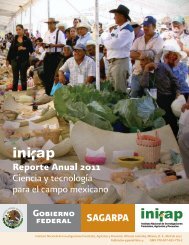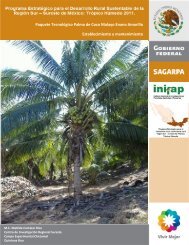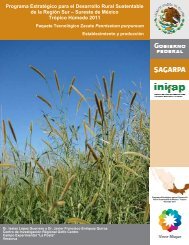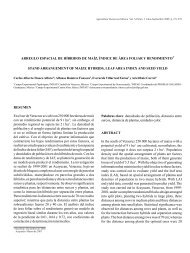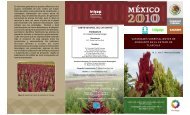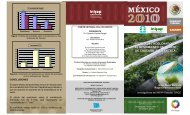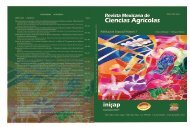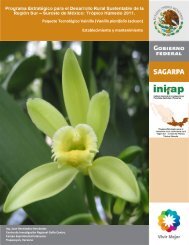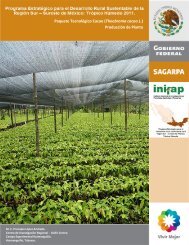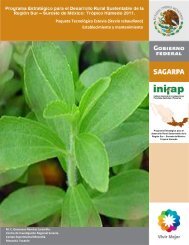artÃÂculos riego, densidad de plantas y fertilización nitrogenada
artÃÂculos riego, densidad de plantas y fertilización nitrogenada
artÃÂculos riego, densidad de plantas y fertilización nitrogenada
You also want an ePaper? Increase the reach of your titles
YUMPU automatically turns print PDFs into web optimized ePapers that Google loves.
1998 the treatments were: 60 and 80 % available soil moisture, 65 000 and 75<br />
000 plants ha-1 and 160 and 220 kg ha-1 N. In both years a random complete<br />
block <strong>de</strong>sign with a split plot arrangement was utilized. Soil moisture treatments<br />
were assigned to large plots and combinations of plant stands and N rates to<br />
the small plots. The effect of increasing soil moisture was positive on all<br />
recor<strong>de</strong>d traits and the higher yields were obtained with 65 000 and 75 000<br />
plants ha –1. In 1997 no differences were observed among N rates, whereas in<br />
1998, 220 kg ha -1 of N produced the highest yield. The combination of 80%<br />
soil moisture, 65 000 plants ha -1 and 220 kg ha -1 of N resulted in a yield of 9 t<br />
ha-1 with the H-311 P maize hybrid un<strong>de</strong>r irrigated conditions in Zacatecas.<br />
Key words: Zea mays, hybrid H-311 P, available soil moisture, yield.<br />
DINÁMICA POBLACIONAL DE MALEZAS EN DIFERENTES SISTEMAS DE<br />
LABRANZA Y MÉTODOS DE CONTROL EN LA ROTACIÓN TRIGO-MAÍZ<br />
WEED POPULATION DYNAMICS IN A WHEAT-MAIZE ROTATION UNDER<br />
DIFFERENT TILLAGE SYSTEMS AND CONTROL METHODS<br />
Fernando Urzúa Soria1, Josué Kohashi Shibata2, Benjamín Figueroa<br />
Sandoval3 y Ángel Martínez Garza4.<br />
1M.C. 2Dr. Parte <strong>de</strong>l trabajo presentado por el primer autor para obtener el<br />
grado <strong>de</strong> Doctor en Ciencias. Especialidad <strong>de</strong> Botánica, 3Dr. Especialidad <strong>de</strong><br />
Edafología, Instituto <strong>de</strong> Recursos Naturales, 4Dr. Especialidad <strong>de</strong> Estadística.<br />
Colegio <strong>de</strong> Postgraduados, 56230 Montecillo, Edo. <strong>de</strong> Méx. México. Fax 595 95<br />
220-47. e-mail: urzua@taurus1.chapingo.mx.<br />
RESUMEN<br />
La investigación se llevó a cabo en el Campo Experimental <strong>de</strong> la Universidad<br />
Autónoma Chapingo, Chapingo, Edo. <strong>de</strong> Méx., <strong>de</strong> 1994 a 1997 en ocho ciclos<br />
agrícolas. Se evaluaron cuatro sistemas <strong>de</strong> labranza: 1) tradicional o<br />
convencional, 2) mínima, 3) cero y 4) siembra directa, en combinación con<br />
métodos <strong>de</strong> control <strong>de</strong> malezas (manual, químico y sin control) sobre la<br />
dinámica poblacional <strong>de</strong> las especies más importantes en la localidad <strong>de</strong><br />
prueba. Se cuantificó la <strong><strong>de</strong>nsidad</strong> y cobertura <strong>de</strong> las malezas a los 25 y 115<br />
días <strong>de</strong>spués <strong>de</strong> la emergencia <strong>de</strong> los cultivos y al final <strong>de</strong> cada ciclo se estimó<br />
su rendimiento. En el último año <strong>de</strong>l estudio se <strong>de</strong>terminaron algunas<br />
propieda<strong>de</strong>s físicas <strong>de</strong>l suelo para ver el efecto <strong>de</strong> los diferentes sistemas <strong>de</strong><br />
labranza. Durante el estudio se registraron 48 especies <strong>de</strong> malezas: 31<br />
ocurrieron en trigo, 45 en maíz y 28 en ambos cultivos. Las poblaciones <strong>de</strong><br />
Simsia amplexicaulis, Amaranthus hybridus y Chenopodium album se<br />
incrementaron con los tratamientos <strong>de</strong> labranza tradicional o convencional y<br />
mínima; en tanto que las <strong>de</strong> trigo espontáneo (actuando como maleza) Triticum<br />
aestivum, Cynodon dactylon, Bromus catharticus, Reseda luteola y Rumex<br />
crispus, lo hicieron en los tratamientos <strong>de</strong> labranza cero y siembra directa.<br />
Brachiaria plantaginea, Cyperus esculentus, Oxalis latifolia, Malva parviflora,



